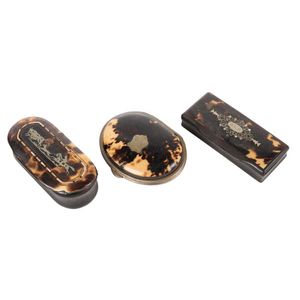19th Century Tortoiseshell and Horn Snuff Boxes and Purse
You must be a subscriber, and be logged in to view price and dealer details.
Subscribe Now to view actual auction price for this item
When you subscribe, you have the option of setting the currency in which to display prices to $Au, $US, $NZ or Stg.
- Pique Work - A decorative technique used on jewellery and small decorative objects in which designs are created by inlaying small gold or silver studs and stips into tortoiseshell. The art reached its highest point in 17th- and 18th-century France, particularly for the decoration of small tortoiseshell articles such as combs, patch boxes, and snuffboxes.
- Mother-Of-Pearl - Mother-of-pearl, technical name "nacre", is the inner layer of a sea shell. The iridescent colours and strength of this material were widely used in the nineteenth century as an inlay in jewellery, furniture, (especially papier mache furniture) and musical instruments.
In the early 1900s it was used to make pearl buttons. Mother-of-pearl is a soft material that is easily cut or engraved.
Nowadays it is a by-product of the oyster, freshwater pearl mussel and abalone industries. - Horn - Full horns were used for making drinking vessels and powder horns. A number of larger horns or antlers could be combined together to make furniture and decorative items such as chairs and lamps.
As a material, horn was formerly used in all types of objects such as snuff boxes, lanterns, musical instruments, items for personal grooming, cutlery handles, walking sticks. Some items of horn are finely decorated with silver or mounted in silver. - Tortoiseshell - Tortoiseshell is a translucent material that comes from the horny carapace of a certain types of turtles, including the hawksbill turtle. It is often therefore mounted on a colour underground - often red - or inlaid with gold or silver thread, as seen in Boulle furniture.
The texture and colour nuances of the material are extremely important. Heated tortoiseshell can easily be formed into various shapes. Like other natural materials, tortoiseshell becomes more beautiful with use. In a time before plastic, tortoiseshell was widely used for small objects such as combs and powder compacts.
In 1973, the trade of tortoiseshell worldwide was banned under CITES (The Convention on International Trade in Endangered Species). Prior to importing or exporting items containing tortoiseshell a CITES permit must be obtained. Tortoiseshell items cannot be traded on Ebay.
"Faux tortoiseshell", another case of man initiating nature, is made from old-style plastics such as celluloid and cellulos and is coloured with red, yellow and brown spots to imitate the genuine article. It is commonly used in glasses frames, musical instruments and costume jewellery.
This item has been included into following indexes:
Visually similar items

A 'Graffiti' band ring by Camilla Gough handcrafted with titanium, gold rivets, engraved with 'Graffiti' motifs, mounted in sterling silver, circa 2006, ring size V

Tortoise shell and horn snuff box, purse and paperweight

Georg Jensen, silver brooch, model no. 65, decorated with flowers, stamped 'G J sterling 925 Denmark 65', approx. Weight 15.7 grams

A gold signet ring, attributed to Matcham Skipper, Montsalvat, circa 1970's. The central oval panel with figures of a standing couple. 18ct yellow gold. Weight 14.84 grams. Size N.
